

BPM Cyber Monday: Camunda 7.2 Adds Tasklist And CMMN. I caught up with Jakob Freund and Daniel Meyer of camunda last week in advance of their 7.2 release; with 1,700 person-days of work invested in this April-November release cycle, this includes a new tasklist application, an initial implementation of the Case Management Model and Notation (CMMN) standard, developer accelerators particularly for non-Java developers, and performance and stability improvements.
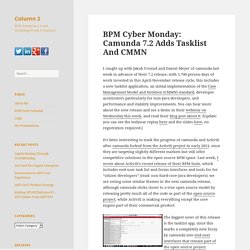
You can hear more about the new release and see a demo in their webinar on Wednesday this week, and read their blog post about it. [Update: you can see the webinar replay here and the slides here, no registration required.] It’s been interesting to track the progress of camunda and Activiti after camunda forked from the Activiti project in early 2013, since they are targeting slightly different markets but still offer competitive solutions in the open source BPM space.
BPM Team Blog: The Case for Open Source Embedded Case Management. In camunda BPM we enhance our lightweight embedded BPMN Process Engine with case management features based on CMMN.
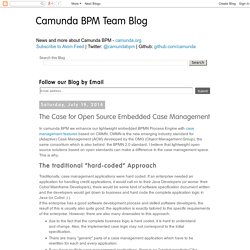
CMMN is the new emerging industry standard for (Adaptive) Case Management (ACM) developed by the OMG (Object Management Group), the same consortium which is also behind the BPMN 2.0 standard. I believe that lightweight open source solutions based on open standards can make a difference in the case management space. This is why. The traditional "hard-coded" Approach. Camunda BPM Team Blog: The Case for Open Source Embedded Case Management. Camunda/camunda-cmmn-model. BPMN and CMMN Compared - Business Process Watch. IBM’s presentation at bpmNEXT of their implementation of case management inside of BPMN (and their subsequent launch of same at Impact) inspired Paul Harmon to start a lively thread on BPTrends on whether BPMN and CMMN should be merged.
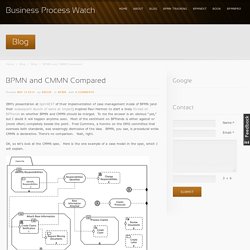
To me the answer is an obvious “yes,” but I doubt it will happen anytime soon. Most of the sentiment on BPTrends is either against or (more often) completely beside the point. Fred Cummins, a honcho on the OMG committee that oversees both standards, was sneeringly dismissive of the idea. BPMN, you see, is procedural while CMMN is declarative. There’s no comparison. OK, so let’s look at the CMMN spec. The outer container, with the tab that looks like a manila folder, is the case file. The octagons, called stages, are fragments of case logic. The rounded rectangles are tasks, and the icon in the upper left signifies the task type. The # markers mean retriggerable tasks. The double rings that look like BPMN intermediate events are CMMN event listeners. It’s Not About BPM vs. ACM, It’s About A Spectrum Of Process Functionality. From a white paper that I’m working on now: I think that the whole “BPM versus ACM” debate has completely blown out of all sensible proportion, when we’re really talking about a spectrum of functionality that ranges from structured process management (or what some people think of as BPM) to completely dynamic process management.
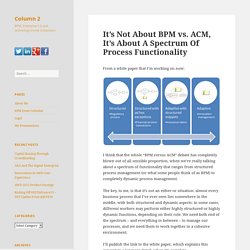
The key, to me, is that it’s not an either-or situation: almost every business process that I’ve ever seen lies somewhere in the middle, with both structured and dynamic aspects: in some cases, different workers may perform either highly structured or highly dynamic functions, depending on their role. We need both end of the spectrum – and everything in between – to manage our processes, and we need them to work together in a cohesive environment. I’ll publish the link to the white paper, which explains this concept in a lot more detail, when it’s complete. Camunda BPM 7.2: CMMN Case Management (English) Adaptive Case Management Modeling with CMMN by Jessica Ray (SOA & BPM Partner Community Blog)
A new version of Oracle BPM Suite 11.1.1.7 with Adaptive Case Management (ACM) is now available, so what will that mean for requirements gathering?
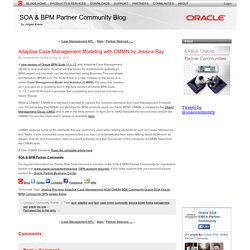
BPM project requirements can be documented using Business Process Model and Notation (BPMN 2.0). For ACM, there is a new notation in the works. It is called Case Management Model and Notation (CMMN). For now, this notation isn’t included as a modeling tool in the new version of Oracle BPM Suite 11.1.1.7 with ACM, but it is possible that a modeling tool could be included in a future release. What is CMMN?
CMMN captures some of the elements that are commonly used when talking about ACM such as Cases, Milestones, and Tasks. A Few CMMN Elements Read the complete article here SOA & BPM Partner Community Blog. Adaptive Case Management for Business Analysts and CMMN. Case Management and Business Process Management - Apply CMMN successfully Model, analyze, improve Business Processes with CMMN Target Audience: Case Manager, Business Process Analysts, Business Analysts, Enterprise Architects, Business Architects, Business Process Manager Course Type: Open Workshop, English, 2-Day-Workshop Business Processes are an essential success factor for all enterprises.
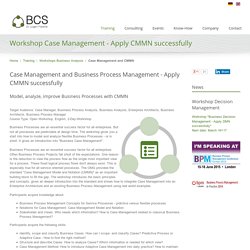
But not all processes are predictable at design time. Business Processes are an essential success factor for all enterprises. MOD research group. FTF Beta 1 (January 2013) The FTF Beta 1 version of the CMMN specification is now publicly available at: Finalization Task Force (December 2012) The CMMN proposal passed the OMG voting and is now undergoing finalization towards an official version 1.0 specification:
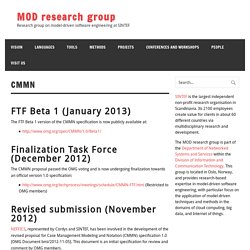
CMMN 1.0. BPM-Trilogy - BPMN, CMMN, DMN. Complete Business Process Management for Business Analysts: Master your BPM-Project Target Audience: Business Process Manager, Business Analysts, Business Process Modeler, Business Process Analysts, Case Manager, Enterprise Architects, Business Architects Course Type: Open Workshop, English, 3-Day-Workshop Business Processes are an essential success factor for all enterprises.
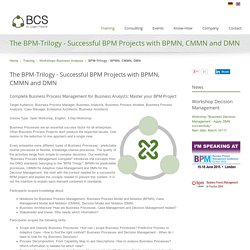
Often Business Process Projects don't produce the expected results. One reason is the reduction to one approach and a single view. Every enterprise owns different types of Business Processes - predictable routine processes or flexible, knowledge intense processes. Example: CMMN Scrum example. We illustrate an example of CMMN being applied to engineering projects by modeling selected parts of the Scrum project management practice.
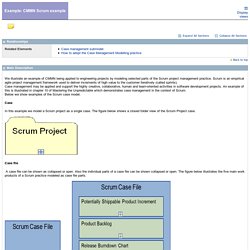
Scrum is an empirical agile project management framework used to deliver increments of high value to the customer iteratively (called sprints). Case management may be applied and support the highly creative, collaborative, human and team-oriented activities in software development projects. An example of this is illustrated in chapter 10 of Mastering the Unpredictable which demonstrates case management in the context of Scrum. Below we show examples of the Scrum case model. CMMN Web Modeler. Free Web CMMN, Free Web CMMN 2.0 - BPI. Camunda BPM Team Blog: Embedded Case Management with CMMN in camunda BPM. In our latest alpha release we include a preview of the upcoming support for CMMN (Case Management Model and Notation) in camunda BPM.

Time to have a look at CMMN and the way it is implemented in camunda BPM. CMMN 1.0 Implementation Reference. Plan Items and Item Definitions¶ CMMN differentiates between plan items and plan item definitions. While plan items represent actual units of work that are enacted as part of the case, plan item definitions serve as the blueprint for how a plan item has to be enacted. This concept simplifies reuse of plan item definitions and furthermore enables dynamic planning such that additional items can be generated at runtime from a definition. As an example, consider the following fragment of a case definition: This model contains one plan item definition, namely the humanTask element. Accordingly, a case plan model that contains plan item definitions but no plan items will appear as a case with no tasks at runtime. Apart from reuse of configuration, plan item definitions can be instantiated at runtime, typically referred to as planning. This reference describes, if not otherwise noted, the plan item definitions supported by the Camunda engine.
Entry and Exit Criteria¶